Objective:
This case study examines how typography influences user experience (UX) by improving readability, emotional engagement, and overall usability, focusing on the redesign of an e-commerce website.
Background
An online fashion retailer faced challenges with high cart abandonment rates and low session durations. Feedback revealed that users found the website visually overwhelming and difficult to navigate, largely due to poor typography choices.
Research Phase
- User Feedback:
- Surveys highlighted issues with inconsistent font styles, poor readability, and unclear emphasis on key content.
- Users felt the design lacked a modern and professional feel.
- Analytics:
- Heatmaps showed users struggling to identify product details and calls-to-action (CTAs).
- Session recordings revealed frustration with long product descriptions.
- Competitive Analysis:
- Benchmarked typography practices on leading e-commerce sites, noting the importance of clean, legible fonts and consistent hierarchy.
Design Implementation
1. Font Selection:
- Primary Font: Selected a sans-serif font (Lato) for a clean, professional look.
- Secondary Font: Added a serif font for product descriptions to evoke trust and luxury.
2. Readability Optimization:
- Increased the base font size from 12px to 16px for easier readability.
- Adjusted line spacing to 1.6 for better text flow.
3. Text Hierarchy:
- Established a clear hierarchy with distinct font sizes and weights:
- H1: Bold, 28px for headlines.
- H2: Regular, 22px for subheadings.
- Body text: Regular, 16px.
- Used color contrast to highlight key information like discounts and CTAs.
4. Responsive Typography:
- Implemented scalable typography to ensure readability on all devices.
- Tested font rendering on various browsers and screen resolutions.
Testing Phase
- A/B Testing:
- Compared the old design with the new typography-focused design.
- Tracked engagement metrics such as time spent on pages and click-through rates.
- User Testing:
- Conducted usability tests to gather qualitative feedback on the improved typography.
- 85% of participants found the new design easier to read and navigate.
Results
- Session Duration: Increased by 35%, indicating improved engagement.
- Cart Abandonment Rate: Dropped by 20%, as users found product information clearer.
- Conversion Rate: Increased by 18%, driven by visually appealing CTAs.
- User Feedback: Overwhelmingly positive, with users describing the site as “modern,” “easy to use,” and “visually clean.”
Conclusion
Typography plays a pivotal role in UX by ensuring content is readable, guiding users’ attention, and shaping perceptions of professionalism and trustworthiness. This case study demonstrates how thoughtful typography choices can directly impact usability, engagement, and business outcomes.
Key Takeaway:
Investing in typography is not just about aesthetics—it’s about crafting a seamless and enjoyable user experience that drives results.



